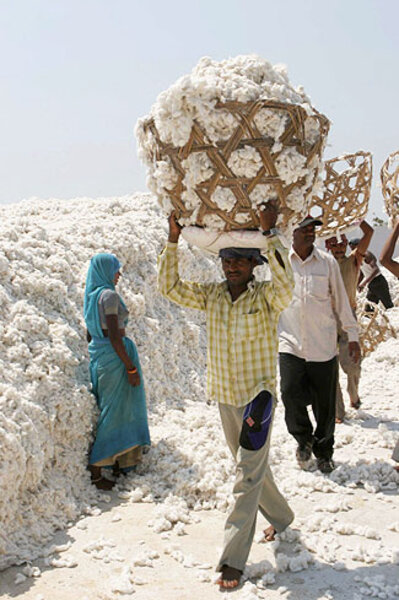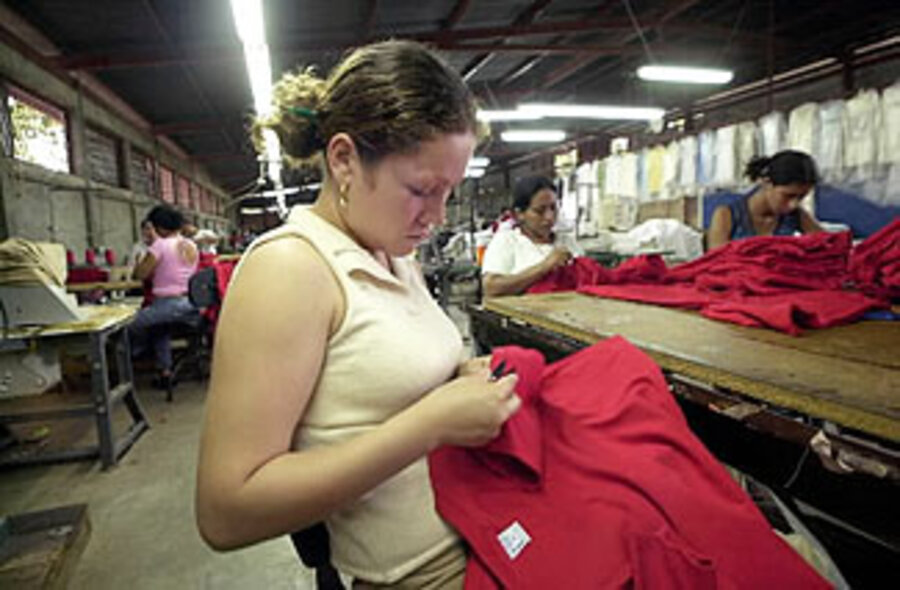Is America ready for eco-fashion?
| London
Now, People Tree faces perhaps its biggest challenge. In the midst of the largest global recession in postwar history, will cash-strapped consumers keep snapping up the company's premium-priced fair-trade apparel?
It's a question the entire fair-trade industry is asking. The whole premise of fair-trade goods hangs on the idea that first-world consumers will pay a little extra to give third-world artisans and farmers a living wage. A deep recession could stop fair-trade companies in their tracks.
So far, that hasn't happened here in Britain. By this summer, Cadbury expects all its Dairy Milk bars in Britain and Ireland to be made from fair-trade cocoa. By year end, Starbucks plans to serve only fair-trade coffee in the United Kingdom. In 2008, sales of fair-trade certified cotton doubled from 2007 levels to 20 million units.
"Fair trade can compete if it comes in at a slightly higher price, or even a significantly higher price," says Vanessa Paar, business development manager at Fairtrade Foundation, which grants fair-trade status to products sold in Britain and is one of 20 national certifying groups operating under the umbrella of the Fairtrade Labeling Organizations International. "It depends on the aesthetic of the garments, economies of scale, and the business strategy."
Minney's strategy is to weave environmental as well as fair-trade standards into her high-fashion clothes. She charges a premium to cover the extra costs of sourcing 50 percent of her line with organic cotton and working exclusively with hand weavers, who don't contribute the carbon emissions that power looms do in conventional garment factories.
Other retailers, concentrating solely on fair-trade payments to farmers, don't charge extra.
"If we convert a garment to fair trade, say, a white T-shirt, and previously that style cost £7 ($10.31), the fair-trade version will cost £7," says Lucy Kelly, a spokeswoman for the Marks & Spencer supermarket chain.
As Britain's leading garment retailer by volume, Marks & Spencer has sold 4.8 million fair-trade garments since launching the program in 2007. With sales up by 105 percent in the first six months of 2008, the retailer believes it's on track to move an additional 15 million items by 2012.
A company like Marks & Spencer can stay competitive because the cost of the cotton fiber in the finished garment is very small – typically less than 5 percent of the entire cost, according to Damien Sanfilippo, a cotton project manager at Pesticide Action Network, an international coalition advocating ecologically sound farm practices.
Although British Fairtrade certification sets a standard for how cotton farmers are paid, it doesn't distinguish whether their goods are grown organically or what labor practices were used in their processing or manufacture. But overlapping consumer concerns may bring them together.
"Fair trade can provide a stepping stone for farmers to convert to organic because it's easier to become fair-trade certified," says Mr. Sanfilippo, "Once they have access to a premium market [through higher fair-trade prices], they can decide to use the premium to finance the training that they need to move towards more sustainable practices – all the way up to organic."
Fair trade and organic are highly dependent upon income and price, so retailers may see decreased demand, notes Saqib Jafarey, an international trade economist with the City University of London. But if they keep prices in line it's possible some companies could expand their fair-trade offerings – even in a recession.
"The recession may actually shift the balance from the usual kinds of trade to a more ethical trade," says Professor Jafarey, "if people begin to take into account the environmental impact in the production of these items."
Indeed, more than 70 percent of the British populace recognize the fair-trade mark, whereas consumer recognition in the United States is only 28 percent, according to recent surveys.
TransFair USA, the nonprofit that licenses products to carry the fair-trade certified label on agricultural products, says it is looking into establishing standards for apparel. But fair-trade fashion faces significant hurdles in the US.
"It's quite easy for the fiber industry to develop their own weak ecolabels in order to pull the wool over the eyes of consumers," says Craig Minowa, an environmental scientist with the Organic Consumers Association.
American fair-trade fashion has already arrived, says Lynda Grose, a sustainable fashion design pioneer, although it's not yet advertised as such. Companies like Eileen Fisher, Levi's, and American Apparel all incorporate elements of fair trade.
In the US, organic products crowd out the fair-trade message, but the biggest hurdle remains in making the link between individual purchases to development work and wages in far-off countries, says Carmen Iezzi of the Fair Trade Federation in Washington, D.C.
In one study, fewer than 6 percent of Americans could name a fair-trade organization unaided, according to a report last month by the federation.
"In an economic climate where nearly 55 percent of consumers are said to be trimming what they consider to be discretionary spending ... it is clear that Fair Trade Organizations have not yet engaged a potentially receptive audience in their work," the report concluded.
Even in Europe, fair trade has not yet become mainstream. The average consumer in Switzerland, which has seen more penetration of fair-trade products than any other nation, still buys only ¤21 ($28) worth of such goods per year, according to a December report by the Dutch Association of Worldshops.
Ultimately, the fringe quality of its customer base may be what insulates fair-trade apparel from the chill winds of recession. If the customers are mostly well-educated professionals, then perhaps they're less likely to lose their jobs and cut back on purchases.
That's not the customer base that most fair-trade advocates want, however.
"I think it's important it [fair trade] isn't just a nice cozy middle-class thing to do," says Minney, who links up with hot young designers and supermodels willing to collaborate for the cause.
But the key to her success is her years in the field working with farming cooperatives and slum-based activists, as well as garment workers and jewelrymakers.
For example, Minney and her design team are working with a community project employing 2,000 low-caste hand weavers in the remote Katmandu Valley in Nepal.
Few ethical labels have yet figured out how to scale up to that size, fair-trade consultants say. Consequently, only a few companies have begun developing cohesive, full-bodied fashion labels – the prerequisite to brand recognition which Minney has seemingly achieved.
"It's a tricky thing to cover technical assistance and the capacity building and campaigning work that goes into building a market," says Minney, "but [this] is a different model, one that can make an enormous difference in people's lives."








